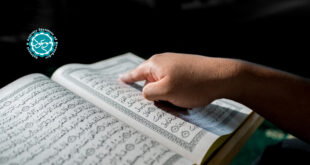The Event of Ghadir Khumm
The Prophet, on his way back, got at a place named Ghadir Khumm where the Arab tribes separated from each other to start off towards their dwellings.
At this time a verse was revealed to the Prophet saying:
“O Apostle, deliver what has been revealed to you from your Lord; and if you do it not, then you have not delivered His message, and Allah will protect you from the people; surely Allah will not guide the unbelieving people”. (5:67)
The verse purported that the Prophet (S) had been charged with a great duty previously but he was afraid of people’s mischief to reveal it.
The Prophet ordered that those, who had gotten ahead, to come back and those, who were late to hurry to the place.
When all the pilgrims gathered, the Prophet went up a pulpit, which was made of camels’ saddles. After praising God he said: “Am I not closer to you than you to yourselves?” These saying indicated to the Holy Qur’anic verse:
“The Prophet is closer to the Believers than their own selves”. (33:6).
The present people said: “Yes, you are.”
Afterward the Prophet grabbed ‘Ali (as) by the arm and said:“Whomsoever I am his guardian, here is ‘Ali to be his guardian.”
Then he prayed to God and said: “O Allah, be a supporter of whoever supports him (‘Ali) and an enemy of whoever opposes him”. He added: “I and ‘Ali have come into being from the same origin but the others have come from different origins.”
Imam ‘Ali (as) was hereby introduced as the Prophet’s successor and all those present people, who were more than one hundred thousand, congratulated him and shook hands with him especially ‘Umar ibn al-Khattab, rejoiced more than the others. He said to ‘Ali: “`Well- done, well-done! You became my guardian and the guardian of every believing man and believing woman.”
More than three hundred and fifty great Sunni scholars14 mentioned this tradition. Some of them researched this subject in independent books.
When those formalities of allegiance were finished, a verse was revealed:
“This day have those who disbelieve despaired of your religion, so fear them not, and fear Me. This day have I perfected for you your religion and completed. My favor on you and chosen for you Islam as a religion”. (5:3)
Some scholars thought that this verse was revealed when the hajj was all over in Mecca but some others15 thought that it was revealed in Ghadir Khumm to show the willingness of God in appointing Imam ‘Ali (as) as the leader of the believers after the Prophet.
According to the Shia opinion, the imamate (caliphate after the Prophet) is a divine rank and as the prophets were chosen among the best and wisest people, the imam also should be chosen in the same way among the innocent and pious men.
The caliph must be able to clarify the vague problems and could answer the scientific questions of religion, which were brought forth for discussion, without falling into error, because the caliphate was indeed an integral part of the prophet hood.
Therefore God knew better which one was well- qualified to the task.
The said tradition and the following short story are convincing evidences for the Shia to prove the immediate succession of Imam ‘Ali (as) after the Prophet’s death.
One day a beggar came into the mosque of Medina and asked for alms. He repeated his request several times but no one granted him anything. Imam‘Ali (as) stretched his finger out while he was kneeling in offering prayer so that the beggar would take Imam ‘Ali’s ring off his finger.
Just then a verse was revealed:
“Only Allah is your lord and His apostle and those who believe, those who keep up prayers and pay the poor-rate while they bow”.16 (5:55)
Now by taking into consideration this Qur’anic verse and the Prophet’s clear and decisive words in Ghadir Khumm, we knew that Imam ‘Ali (as) was the rightful heir and legal successor of the Prophet (S).
Of course there are many other crucial evidences in this regard through the Holy Qur’an and the other reliable sources but this matter cannot be contained by this book and it needs an independent book by itself.
Notes:
1. Refer to Imam Ahmad ibn Hanbal’s Musnad vol.1 p.p.111,159,333, ath-Tha’labi’s Tafseer, al-Khawarizmi’s Manaqib, Nooruddeen as-Sabbagh al-Maliki in his book al- Fusool al-Muhimma p.p.14, Abu Na’eem al-Isfahani in his book Hilyatul Awliya’ and many others.
2. Abu Ishaq ath-Tha’labi, Fadhil an-Nayshaboori, al-Fakhr ar-Razi, Jalaluddeen as-Sayooti, Abu Na’eem al-Isfahani, al- Khawarizmi, Muhammad ibn Yousuf al-Ganji, Imam Muhammad al-Ghazali and many others.
3. Refer to al-Bukhari’s Sahih, vol.3 p.p.54, Muslim’s Sahih, vol.2 p.p.236-237, Ahmad’s Musnad, vol.1 p.p.98,118-119, Jalaluddeen as-Sayooti’s Tareekh al-Khulafa’, al-Mas’oodi’s Murooj ath-Thahab,vol.2 p.p.49 and Abu Abdullah an- Nayshaboori in his Mustadrak, vol.3 p.p.9.
4. Refer to Sharh Nahj al-Balaghah by ibn Abul Hadeed, vol.3 p.p.276, al-Fusool al-Muhimma by Nooruddeen al-Maliki p.p.43 and as-Seera al-Halabiyya by al-Halabi, vol.3 p.p.123.
5. Refer to Ahmad’s Musnad, Ibnul Maghazili’s Manaqib, Muwaffaq ibn Ahmad’s Manaqib, at-Tarmithi’s Sahih, ibn Maja’s Sunan p.p.92, Muhammad ibn Yousuf al-Ganji in his book Kifayatut Talib and many others.
6. Al-Hakim an-Nayshaboori in his Mustadrak, vol.3 p.p.32, al-Mas’oodi in his Murooj ath-Thahab and at-Tabari in his Tareekh.
7. Abu Na’eem al-Isfahani in his book Hilyatul Awliya’, vol.1 p.p.62, Muhammad ibn Talhah ash-Shafi’ei in his book Matalib as-Su’al p.p.4, Muhammad ibn Yousuf ash-Shafi’ei in his book Kifayatut Talib chap.14, al-Bukhari in his Sahih p.p.100 and ibnul Hajjaj in his Sahih, vol.2 p.p.324.
8. Ahmad’s Musnad, ibn Maja’s Sunan, Muhammad ibn Yousuf al-Ganji in his Kifayatut Talib chap.14, Sheikh Sulayman al-Balkhi al-Hanafi in his book Yanabee’ul Mawadda chap.6 and ibn Hajar in his Issaba, vol.2 p.p.508.
9. Refer to Ath-T ha’labi’s Kashful Bayan, Jalaluddeen as -Sayooti’s Tafseer, vol.4 p. p.177 (ad-Durr al-Manthoor), Abul Qassim al-Hasaqani’s Tareekh, ibn Katheer‘s Tareekh, Sheikh Sulayman al-Balkhi’s Yanabee’ul Mawadda and ibn Mar dwayh’s Tafs eer.
10. Qur’an 17:26.
11. ‘Ali ibn Burhanuddeen ash-Shafi’ei in his book as-Seera al-Halabiyya, vol.3 p.p.391, ibn Abul Hadeed in his Sharh Nahj al-Balaghah, Yaqoot al-Hamawi in his Mu’jam ul Buldan and as-Samhoodi in Tareekh al-Medina.
12. The Holy Qur an 12:92.
13. It was the great grandfather of the Prophet (S).
14. Al-Fakhr ar-Razi in his book Mafateeh al-Ghayb, ath- Tha’labi in his Kashful Bayan, Jalaluddeen as-Sayooti in his ad-Durr al-Manthoor, Abu Na’eem al-Isfahani in his Hilyatul Awliya’, Ahmad ibn Hanbal in his Musnad, ibnul Maghazili in his Manaqib, at-Tabari in his al-Wilaya, Ahmad ibn Muhammad al-Koofi (ibn Oqda) in his al-Wilaya, ibn Haddad al-Hasakani in his al-Wilaya and many others.
15. Abul qassim al-Hasakani in his book Shawahid at-Tanzeel, sibt ibn aj -Jawzi in his Khawass al-Umm a and Abu Sa’eed as- Sajistani in his al-Wilaya.
16. Al-Fakhr ar-Razi in his Tafseer, vol.3 p.p.431, Abu Ishaq ath-Tha’labi in his Kashful Bayan, az-Zamakhshari in his Kashshaf, vol.1 p.p.422, at-Tabari in his Tafseer vol.6 p.p.186, ibn Abu Shayba al-Koofi in his Tafseer, an-Nassa’ie in his Sahih, Muhammad ibn Yousuf al-Ganji ash-Shafi’ei in his Kifayatut Talib, ibn as-Sabbagh al-Maliki in his al- Fussool al-Muhimma p.p.123 and many others.

 Mouood Mouood English Edition
Mouood Mouood English Edition



